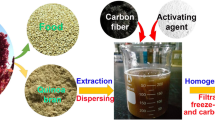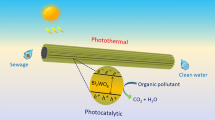Abstract
Wastewater accounts for a large part of the water body on the earth. Solar water evaporation is an effective way to produce fresh water from seawater or polluted water. However, the co-evaporation or deposition of contaminants may reduce the efficiency and freshwater quality during water evaporation. In this work, a self-cleaning solar water evaporator is developed based on the natural lignocellulose fibers (NCF), polyaniline (PANI), and TiO2, which shows great advantages of wide-range light absorption, super hydrophilicity, and low thermal conductivity. Nanofibrous PANI is polymerized on the surface of NCF to form a mesoporous network by adding the NCF to the polymerization solution. P25 TiO2 nanoparticles as photocatalysts are dispersed into the above reaction to form the hybrid PANI/TiO2/NCF composite disc by simply filtration. Owing to the synergistic effect between the photothermal PANI and the photocatalytic degradation of TiO2 nanoparticles in the solar water evaporator device, the water evaporation rate can reach 2.36 kg m−2 h−1 (under 1 sun irradiation), and the contaminant (100 ppm tetracycline) can be efficiently degraded. Interestingly, the solar water evaporator device still maintains a constant solar evaporation rate after working for 10 h, and no contaminant is accumulated. The bifunctional solar water evaporation device, which combines photocatalytic and photothermal effects, has great potential application in organic contaminant water with a self-cleaning effect.

摘要
水体污染是当前造成淡水短缺的主要原因之一. 利用太阳能水蒸发装置从海水或污水中生产淡水是一种简单有效且节能的解决淡水危机的方式, 引起了广泛的关注. 然而, 污染物的共同蒸发或沉积可能会降低水蒸发过程中的效率和淡水质量. 本文基于天然木质纤维素(NCF)、聚苯胺(PANI)和二氧化钛(TiO2)开发了自清洁太阳能水蒸发器, 其具有宽吸收、亲水性强、导热系数低等优点. 通过在聚合物溶液中加入木质纤维素, 聚苯胺纳米纤维在NCF表面聚合形成介孔网络.P25 TiO2纳米颗粒作为光催化剂分散到上述反应液中, 通过简单的过滤形成PANI/TiO2/NCF复合材料. 由于太阳水蒸发器装置中PANI的光热效应与TiO2纳米颗粒的光催化降解的协同作用, 水蒸发速率可达2.36 kg m−2h−1 (1个太阳光照射下), 且可有效降解污染物(100 ppm四环素). 更重要的是, 在工作10 h后, 该太阳能水蒸发器装置仍然保持稳定的水蒸发速率, 且没有污染物的积聚. 光催化和光热效应相结合的双功能太阳能水蒸发装置在有机污染物水中具有自清洁作用, 具有很大的应用潜力.
Similar content being viewed by others
References
Mekonnen MM, Hoekstra AY. Four billion people facing severe water scarcity. Sci Adv, 2016, 2: e1500323
Liu X, Zhang H, Li L, et al. Levels, distributions and sources of veterinary antibiotics in the sediments of the Bohai Sea in China and surrounding estuaries. Mar Pollut Bull, 2016, 109: 597–602
Song L, Li L, Yang S, et al. Sulfamethoxazole, tetracycline and oxytetracycline and related antibiotic resistance genes in a large-scale landfill, China. Sci Total Environ, 2016, 551–552: 9–15
Chen CQ, Zheng L, Zhou JL, et al. Persistence and risk of antibiotic residues and antibiotic resistance genes in major mariculture sites in southeast China. Sci Total Environ, 2017, 580: 1175–1184
Wang Z, Chen Q, Zhang J, et al. Characterization and source identification of tetracycline antibiotics in the drinking water sources of the lower Yangtze River. J Environ Manage, 2019, 244: 13–22
Daghrir R, Drogui P. Tetracycline antibiotics in the environment: A review. Environ Chem Lett, 2013, 11: 209–227
Zhu YG, Johnson TA, Su JQ, et al. Diverse and abundant antibiotic resistance genes in Chinese swine farms. Proc Natl Acad Sci USA, 2013, 110: 3435–3440
Liu H, Yang Y, Sun H, et al. Fate of tetracycline in enhanced biological nutrient removal process. Chemosphere, 2018, 193: 998–1003
Li R, Zhang L, Wang P. Rational design of nanomaterials for water treatment. Nanoscale, 2015, 7: 17167–17194
Gao X, Ren H, Zhou J, et al. Synthesis of hierarchical graphdiyne-based architecture for efficient solar steam generation. Chem Mater, 2017, 29: 5777–5781
Cavusoglu AH, Chen X, Gentine P, et al. Potential for natural evaporation as a reliable renewable energy resource. Nat Commun, 2017, 8: 617
Ray P. Renewable energy and sustainability. Clean Techn Environ Policy, 2019, 21: 1517–1533
Vishwanath Kumar P, Kumar A, Prakash O, et al. Solar stills system design: A review. Renew Sustain Energy Rev, 2015, 51: 153–181
Kabeel AE, El-Agouz SA. Review of researches and developments on solar stills. Desalination, 2011, 276: 1–12
Wu X, Chen GY, Owens G, et al. Photothermal materials: A key platform enabling highly efficient water evaporation driven by solar energy. Mater Today Energy, 2019, 12: 277–296
Deng Z, Zhou J, Miao L, et al. The emergence of solar thermal utilization: Solar-driven steam generation. J Mater Chem A, 2017, 5: 7691–7709
Ni G, Li G, Boriskina SV, et al. Steam generation under one sun enabled by a floating structure with thermal concentration. Nat Energy, 2016, 1: 16126
Ghasemi H, Ni G, Marconnet AM, et al. Solar steam generation by heat localization. Nat Commun, 2014, 5: 4449
Jiang Q, Tian L, Liu KK, et al. Bilayered biofoam for highly efficient solar steam generation. Adv Mater, 2016, 28: 9400–9407
Hao L, Liu N, Niu R, et al. High-performance salt-resistant solar interfacial evaporation by flexible robust porous carbon/pulp fiber membrane. Sci China Mater, 2022, 65: 201–212
Li Y, Jin X, Li W, et al. Biomimetic hydrophilic foam with micro/nanoscale porous hydrophobic surface for highly efficient solar-driven vapor generation. Sci China Mater, 2022, 65: 1057–1067
Guo D, Yang X. Highly efficient solar steam generation of low cost TiN/bio-carbon foam. Sci China Mater, 2019, 62: 711–718
Zhu HW, Ge J, Zhao HY, et al. Sponge-templating synthesis of sandwich-like reduced graphene oxide nanoplates with confined gold nanoparticles and their enhanced stability for solar evaporation. Sci China Mater, 2020, 63: 1957–1965
Zhu M, Li Y, Chen F, et al. Plasmonic wood for high-efficiency solar steam generation. Adv Energy Mater, 2018, 8: 1701028
Chen M, He Y, Huang J, et al. Synthesis and solar photo-thermal conversion of Au, Ag, and Au-Ag blended plasmonic nanoparticles. Energy Convers Manage, 2016, 127: 293–300
Gao T, Wang Y, Wu X, et al. More from less: Improving solar steam generation by selectively removing a portion of evaporation surface. Sci Bull, 2022, 67: 1572–1580
Wang Y, Wu X, Wu P, et al. Enhancing solar steam generation using a highly thermally conductive evaporator support. Sci Bull, 2021, 66: 2479–2488
Xing J, Tong J, Liu Y, et al. A high-efficiency ammonia-responsive solar evaporator. Nanoscale, 2020, 12: 9680–9687
Hao D, Yang Y, Xu B, et al. Bifunctional fabric with photothermal effect and photocatalysis for highly efficient clean water generation. ACS Sustain Chem Eng, 2018, 6: 10789–10797
Zhao X, He Z, Ou W, et al. Narrow-bandgap light-absorbing conjugated polybenzobisthiazole: Massive interfacial synthesis, robust solar-thermal evaporation and thermoelectric power generation. Sci China Mater, 2022, 65: 2491–2501
Yin Q, Zhang J, Tao Y, et al. The emerging development of solar evaporators in materials and structures. Chemosphere, 2022, 289: 133210
Zhang L, Tang B, Wu J, et al. Hydrophobic light-to-heat conversion membranes with self-healing ability for interfacial solar heating. Adv Mater, 2015, 27: 4889–4894
Jiang Q, Gholami Derami H, Ghim D, et al. Polydopamine-filled bacterial nanocellulose as a biodegradable interfacial photothermal evaporator for highly efficient solar steam generation. J Mater Chem A, 2017, 5: 18397–18402
Chen Q, Pei Z, Xu Y, et al. A durable monolithic polymer foam for efficient solar steam generation. Chem Sci, 2018, 9: 623–628
Chen C, Kuang Y, Hu L. Challenges and opportunities for solar evaporation. Joule, 2019, 3: 683–718
Yang Y, Zheng Z, Yang M, et al. In-situ fabrication of a spherical-shaped Zn-Al hydrotalcite with BiOCl and study on its enhanced photocatalytic mechanism for perfluorooctanoic acid removal performed with a response surface methodology. J Hazard Mater, 2020, 399: 123070
Park J. Visible and near infrared light active photocatalysis based on conjugated polymers. J Ind Eng Chem, 2017, 51: 27–43
Tahir M. Well-designed ZnFe2O4/Ag/TiO2 nanorods heterojunction with Ag as electron mediator for photocatalytic CO2 reduction to fuels under UV/visible light. J CO2 Util, 2020, 37: 134–146
Li R, Zhou C, Yang L, et al. Multifunctional cotton with PANI-Ag NPS heterojunction for solar-driven water evaporation. J Hazard Mater, 2022, 424: 127367
Li S, He Y, Wang Y, et al. Simple hierarchical interface design strategy for accelerating solar evaporation. Macromol Mater Eng, 2021, 306: 2000640
Huang J, Virji S, Weiller BH, et al. Polyaniline nanofibers: Facile synthesis and chemical sensors. J Am Chem Soc, 2003, 125: 314–315
Mo Z, Zhao Z, Chen H, et al. Heterogeneous preparation of cellulose-polyaniline conductive composites with cellulose activated by acids and its electrical properties. Carbohydr Polym, 2009, 75: 660–664
Cao S, Rathi P, Wu X, et al. Cellulose nanomaterials in interfacial evaporators for desalination: A “natural” choice. Adv Mater, 2021, 33: 2000922
Sun Y, Zong X, Qu D, et al. Water management by hierarchical structures for highly efficient solar water evaporation. J Mater Chem A, 2021, 9: 7122–7128
Gong F, Wang W, Li H, et al. Solid waste and graphite derived solar steam generator for highly-efficient and cost-effective water purification. Appl Energy, 2020, 261: 114410
Xu Y, Ma J, Han Y, et al. Multifunctional CuO nanowire mesh for highly efficient solar evaporation and water purification. ACS Sustain Chem Eng, 2019, 7: 5476–5485
Li J, Jing Y, Zhou X, et al. Multifunctional photothermal materials based on natural pumices for high efficiency solar-driven interface evaporator. Int J Energy Res, 2021, 45: 20132–20142
Lu Y, Wang X, Fan D, et al. Biomass derived Janus solar evaporator for synergic water evaporation and purification. Sustain Mater Technol, 2020, 25: e00180
Wu P, Wu X, Wang Y, et al. Boosting extraction of Pb in contaminated soil via interfacial solar evaporation of multifunctional sponge. Green Energy Environ, 2022
Ming X, Guo A, Zhang Q, et al. 3D macroscopic graphene oxide/MXene architectures for multifunctional water purification. Carbon, 2020, 167: 285–295
Geng X, Zhang D, Zheng Z, et al. Integrated multifunctional device based on Bi2S3/Pd: Localized heat channeling for efficient photothermic vaporization and real-time health monitoring. Nano Energy, 2021, 82: 105700
Acknowledgements
This work was supported by the National Natural Science Foundation of China (21872001, 51801006, 21805004, and 21671011), Beijing Municipal High Level Innovative Team Building Program (IDHT20180504), Beijing Outstanding Young Scientists Program (BJJWZYJH01201910005017), Beijing Natural Science Foundation (2192005), and Beijing Municipal Science and Natural Science Fund Project (KM201910005016).
Author information
Authors and Affiliations
Contributions
Liu W and Sun Z designed the experiment. Liu W prepared the samples and performed the measurement and characterization with most of the analysis. All authors contributed to the discussion of the results. Liu W and Sun Z led the effort in the writing of the manuscript.
Additional information
Wenning Liu is a PhD student at Beijing Key Laboratory for Green Catalysis and Separation, Department of Chemistry and Chemical Engineering, Beijing University of Technology. Her current research interests focus on polymer-based solar evaporation devices.
Zaicheng Sun received his PhD degree in chemistry from Changchun Institute of Applied Chemistry, Chinese Academy of Sciences (CAS). After that, he started to work as an AvH research fellow at Marburg University in Germany, followed by research associate at UW, UDel, and UNM. He took the professor position at Changchun Institute of Optics, Fine Mechanics and Physics, CAS in 2010. He is currently a professor at the Department of Chemistry and Biology, Beijing University of Technology. His research focuses on the rational design of photocatalysts with high charge separation efficiency and fluorescent carbon dots with tunable emission and their applications.
Conflict of interest
The authors declare that they have no conflict of interest.
Supplementary information
Experimental details and supporting data are available in the online version of the paper.
Rights and permissions
About this article
Cite this article
Liu, W., Li, P., Li, X. et al. Self-cleaning solar water evaporation device based on polyaniline/TiO2/natural cellulose fibers for contaminant water. Sci. China Mater. 66, 1607–1614 (2023). https://doi.org/10.1007/s40843-022-2282-9
Received:
Accepted:
Published:
Issue Date:
DOI: https://doi.org/10.1007/s40843-022-2282-9




